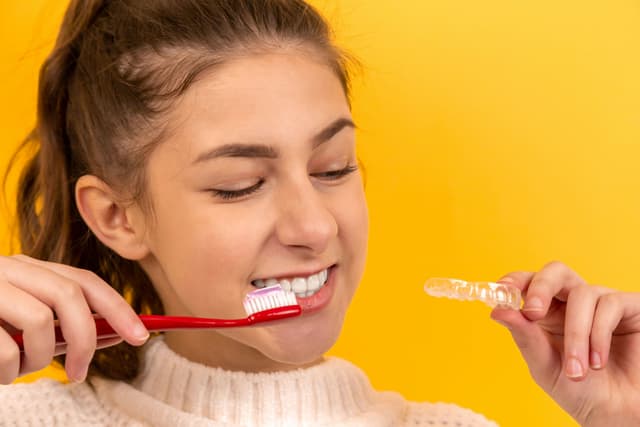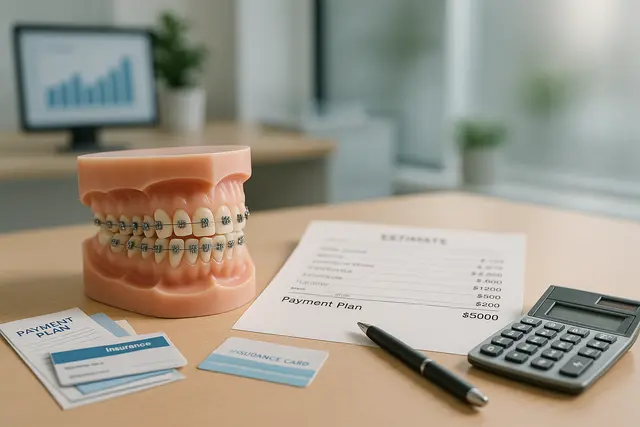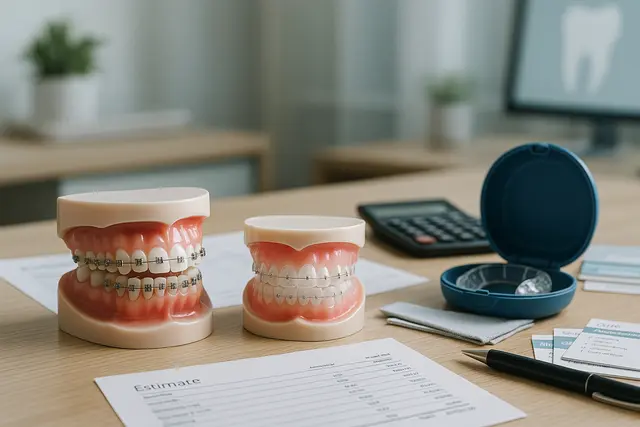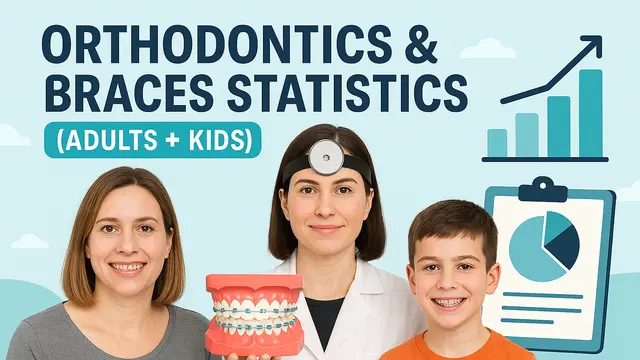Orthodontics
6 min read
Feb 08, 2025
Why Retainers Are Critical for Long-Term Orthodontic Success
Orthodontic treatment is often a significant commitment of time and resources. Once braces or aligners have corrected dental alignment, the work isn't over. Retainers play an essential role in maintaining results and ensuring teeth remain in their new positions.

Retainers Are the Unsung Heroes of Your Orthodontic Journey
Retainers are the key to locking in that perfect smile you worked so hard to earn, yet many orthodontic patients treat the humble retainer like an optional souvenir. We’ll explore why retainers carry more weight than the entire years of orthodontic you just completed.
From the moment the braces are removed or the last aligner clicks out, a custom retainer continues the heavy lifting, guiding teeth in their new positions and fighting the natural urge to shift back to their original positions. Think of it as a personal trainer that never sleeps: small, lightweight, and totally dedicated to keeping your bite balanced.
Your Orthodontic Treatment Doesn’t End When the Braces Come Off
Orthodontic treatment is a significant investment in time, money, and patience. Whether your journey involved treatment with braces or Invisalign, the success of orthodontic treatment does not stop at the end of the orthodontic schedule; it flows straight into the daily use of a retainer.
Orthodontists recommend wearing retainers as directed because the bone around freshly moved roots is as soft as warm wax. Without consistent retainer wear, teeth can creep back to their original positions, undermining the results of orthodontic treatment and your long-term stability.
Retainers Protect the New Smile You Worked So Hard to Achieve
The first night you see your new smile in the mirror is pure magic. That glow, that confidence, that urge to grin at every passer-by, why let it fade? Retainers maintain the orthodontic results you see on day one, ensuring long-term orthodontic success and a long-term smile you’ll still love ten reunions from now. Important to remember that retainers act as your silent bodyguards: they guard position through birthdays, chewing ice, and even the occasional midnight popcorn raid.
What Happens After Your Braces Are Removed? Retainers Step In
The brace era might be over, but the job of holding each tooth where it belongs has just begun. Think of your brace experience as construction and your retainer wear as the curing concrete. Skip that stage, and cracks show up fast. Orthodontists tell every patient that the duration of retainer wear can decide the fate of an otherwise flawless outcome. So before you frame those before-and-after photos, bring your retainer along for the photo shoot; it deserves credit too.
A Fixed Retainer Offers Stability Without the Daily Hassle
A permanent retainer, also called a bonded retainer or lingual retainer, sits quietly behind the front teeth, invisible but unyielding. Fixed retainers are great at blocking any attempt to shift back to their original track because a tiny wire literally ties the teeth together. Around fixed retainers, meticulous flossing is non-negotiable, yet patients love them because the consistent retainer stays put even when life gets hectic. Retainers play a crucial role here: they turn passive stability into an everyday certainty.
Removable Retainers Offer Flexibility with Responsibility
Prefer something you can pop in and out? A removable retainer, think Hawley retainer with its classic wire-and-acrylic design or clear plastic retainers like Essix retainers, offers freedom plus accountability. Retainers as prescribed by your orthodontist need nightly or full-time wear at first, tapering down as bone hardens.
Keep a retainer case on standby at every meal so the dog doesn’t discover a very pricey chew toy. Care for your retainer by giving it a gentle brush with cool water, and remember that replacement retainers cost less than a full retreatment.
Your Orthodontist’s Retainer Advice Isn’t Just a Suggestion
Your orthodontist isn’t being dramatic when they stress retainer wear; they’re reading from decades of data. They know retainers help prevent orthodontic relapse, preserve tooth order, and support long-term success for each patient. If you lose yours, call immediately for an appropriate retainer rather than waiting for teeth to wander. Success of your orthodontic depends on speed, consistency, and yes, a little humble pie when you sheepishly admit you left yours on a cafeteria tray.
Choosing the Type of Retainer That Fits Your Lifestyle
There are two main types most people encounter: fixed and removable retainers, but variations blossom within each family. Your orthodontist chooses the right retainer based on bite pattern, lifestyle, and personality (night owl, snack queen, forgetful teen). Bonded retainers offer set-and-forget security; custom retainer trays give flexibility. The key to long-term confidence is matching personality to device so compliance feels natural rather than forced.
How Retainers Help Preserve Alignment and Stability
Tooth movement is a living thing. Bones remodel, gums shift, and aging muscles tug. Retainers are designed to resist those forces and keep teeth in their new positions day after day. Without them, position drifts like beach sand, eventually erasing the crisp arch you paid for. That’s why orthodontists slide a tiny calendar into every packet spelling out consistent retainer wear: it’s a map to maintaining your orthodontic results for life.
Retainer Care Is Simple but Vital to Their Effectiveness
Retainer care sounds boring, yet it could not be simpler. Rinse with cool water, brush gently with a soft toothbrush, no abrasive toothpaste, and store it dry in its retainer case. Skip boiling water or hot dashboards; heat warps plastic faster than you can say replacement retainers. For bonded varieties, threader floss slides under the wire and sweeps plaque away. Good care of your retainers not only protects oral hygiene but also acts as low-cost insurance against future chair time.
Good Oral Hygiene Starts with a Clean Retainer
Speaking of oral hygiene, every retainer sits in intimate contact with enamel. Food debris trapped underneath becomes a buffet for bacteria, threatening both oral health and the longevity of the appliance. Clean retainers also smell better, and your seatmate on the subway will appreciate that kind gesture. Remember: around fixed retainers plaque accumulates quickly, so prioritize professional cleanings.
Understanding the Proper Use of a Retainer for Long-Term Success
Let’s talk schedules. Orthodontists recommend wearing retainers full-time for the first few months after removal of braces, then night-only for, well, forever. Wearing retainers as directed stabilizes bone, tames gum memory, and ensures the results of orthodontic treatment last. The use of retainers may feel tedious, yet the duration of retainer wear shrinks to a simple bedtime habit before you know it.
Retainers Are a Key Part of Life Beyond Braces or Aligners
Beyond braces lies real life, pizza crusts, chewing gum, even the occasional face-first wipe-out on a skateboard. Retainers to maintain position become safety nets during those unpredictable moments. Retainers also remind you daily of how far you’ve come in your orthodontic journey and why skimping now would feel like tossing a diploma in the trash.
How to Pick the Right Retainer for Your Needs and Habits
Choosing the right retainer involves a quick chat about lifestyle. Musicians who play wind instruments often love a slim Essix. Athletes lean toward a sturdier Hawley while night-time teeth grinders embrace dual-density clear plastic retainers. Your orthodontist factors in oral habits, speech concerns, and even fashion preferences to select the appropriate retainer, ensuring long-term comfort and adherence.
Here’s How Retainers Maintain the Results of Orthodontic Treatment
Retainers maintain order the way a seat belt maintains your position in a sudden stop, they act instantly and tirelessly. Consistent retainer keeps minor forces from rewriting your bite, maintaining the results of orthodontic that cost so much sweat equity. Retainers play silent heroes, asking only a nightly rinse and a brief inspection for cracks.
You Have More Retainer Options Than You Might Think
Today’s retainer options read like a dessert menu: classic Hawley, invisible Essix, lingual wire, clear plastic, even 3-D printed hybrids. Explore why retainers differ, and you’ll find each material tackles a distinct challenge, from stubborn rotations to bite depth. Retainers are so important because they close the final chapter in a story about confidence, self-expression, and the freedom to snack without spinach shame.
Final Thoughts: Retainers Are the Key to Long-Term Orthodontic Success
If you remember nothing else, remember this: wear your retainer as faithfully as you brush your hair. Long-term orthodontic success depends on tiny daily choices, and the importance of retainers cannot be overstated. They were engineered for ensuring long-term stability, and yes, retainers are made to be tougher than late-night snack habits. When you finish treatment with braces or aligners, the story is only half written; discover why retainers are crucial companions on every pillow-talk grin.
Why Are Retainers So Important After Braces or Invisalign?
Retainers hold your teeth in their new positions after orthodontic treatment. Without them, your teeth can gradually shift back, undoing all your hard work. Retainers support bone stabilization and protect your results long-term, acting as the final, essential phase of treatment.
What’s the Difference Between Fixed and Removable Retainers?
Fixed retainers are bonded wires placed behind the teeth, offering 24/7 support without needing daily attention. Removable retainers, like Hawley or Essix types, are worn as directed, usually full-time at first, then nightly. Each type has pros and cons, and your orthodontist will match the style to your lifestyle.
How Long Do I Need to Wear a Retainer?
Most orthodontists recommend full-time wear for the first few months, then switching to nighttime wear indefinitely. Teeth can shift at any age, so wearing your retainer at night for life is the best way to maintain your smile and avoid needing future retreatment.
How Should I Clean and Care for My Retainer?
Clean your retainer daily with cool water and a soft toothbrush, no toothpaste, as it can scratch the surface. Avoid hot water or leaving it in the sun, and always store it in its case. For fixed retainers, use floss threaders or a water flosser to prevent plaque buildup.
Read Next
Related Posts

Orthodontics
How Much Are Metal Braces? Cost Comparison With Other Options
Thinking about getting braces but overwhelmed by the cost? You’re not alone. Orthodontic treatment can be a major investment, and understanding the different price points, from metal braces to clear aligners, can help you make a smart, confident decision.
5 min read
Sep 15, 2025

Orthodontics
Retainer That Looks like Braces: Benefits for Long-Term Alignment
A retainer might not get as much attention as braces, but it plays a crucial role in maintaining your smile after orthodontic treatment. Whether you're new to retainers or curious about the type that looks like braces, understanding their purpose and benefits is key to keeping your teeth aligned for the long haul.
6 min read
Sep 15, 2025

Orthodontics
Orthodontics & Braces Statistics (Adults + Kids)
Orthodontics has transformed from a niche medical service for teenagers into a booming sector that spans all ages. Today, both adults and children seek orthodontic treatment to improve their smiles, fix bite issues, and boost self-confidence.
4 min read
Aug 21, 2025
Don’t have time to research every dentist around you?
See why 30k+ patients trusted us